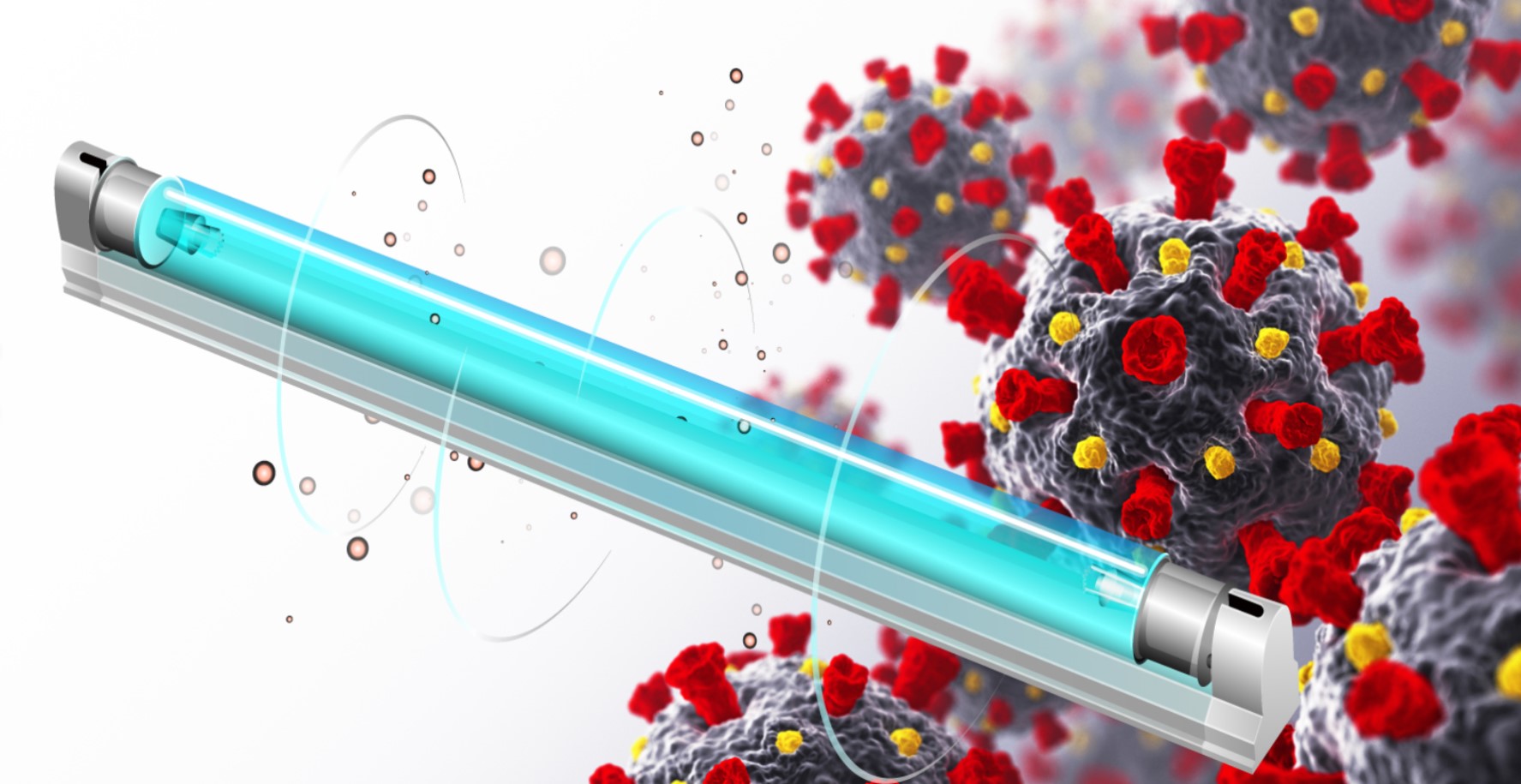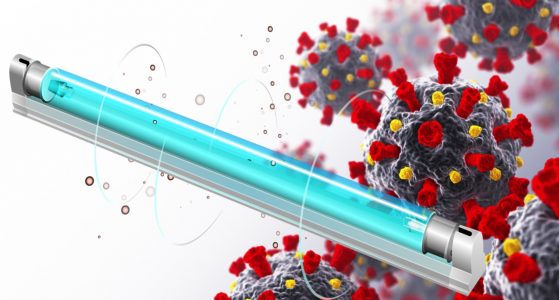Killing bacteria with UV light is highly effective when using UVC germicidal lamps, which are designed to emit shortwave UVC radiation. This radiation has been proven to kill many types of bacteria, as well as viruses, mold, mildew, harmful pathogens, and foul odors. UV light can be divided into UVA 320-400 nm, UVB 290-320 nm, and UVC 100-290 nm, based on the wavelength, measured in nanometers (nm). UVC light, when emitted from the sun, is shorter in wavelength than UVA and UVB and is entirely absorbed by the ozone layer.
UVC light exposure would cause damage to human skin and eyes, and caution must be taken when UVC germicidal lamps are in use. However, many types of UVC disinfection systems are designed to kill bacteria without posing a risk to human health.
How Does UV Light Kill Bacteria?
UV light has been used to kill bacteria for more than a century, as this article points out. When Finsen experimented with UV light 130 years ago, and then in 1877, Downes and Blunt published an article titled “The Influence of Light Upon the Development of Bacteria.” UVC light emits a high-frequency, shortwave electromagnetic radiation that effectively kills bacteria, viruses, and many harmful microorganisms by altering the DNA, which renders the cells unable to replicate. This inactivation of the microbes causes cell death, mutations, and failure to reproduce, thus rendering cells harmless.
What Types of Germs and Bacteria Does UV Light Kill?
UVC radiation is highly effective at eliminating many types of bacteria, including drug-resistant bacteria called superbugs, viruses, including many types of flu strains, beta coronaviruses, including MERS, SARS, and the SARS-CoV-2 virus that causes COVID-19. Some of the most stubborn bacteria that UVC light is proven to eliminate include:
• MRSA (Methicillin-Resistant Staphylococcus Aureus)
• Salmonella
• ESBL-producing Escherichia coli (E. coli)Vancomycin-resistant Enterococcus faecium (VRE)
• Clostridium difficile
• Multidrug-resistant pseudomonas
• Carbapenemase-resistant Klebsiella pneumoniae (KPC)
UVC light effectively eliminates these types of bacteria and many others up to 99.99%, as reported in this study regarding the effectiveness of ultraviolet air and surface disinfection systems.
Killing Bacteria with UV Light: Effective in Many Environments
UVC germicidal lamps are used in a wide range of disinfection applications, providing effective disinfection of water, surfaces, and air.

Water UV disinfection – germicidal lamps are used to kill harmful microorganisms and bacteria in water with UVC radiation in many environments including pools and spas, wastewater treatment, drinking water, aquaculture, ballast water treatment for ships, and many other types of water disinfection needs. UV lamps are one of the most effective water disinfection methods and are proven to inactivate pathogens such as Cryptosporidium and Giardia, which chlorine is unable to treat.
Surface UV disinfection – UVC lamps are used to disinfect surfaces in many industries and applications, including hospitals, restaurants, schools, commercial and industrial properties, and public places.


Hospitals – UVC lamps disinfect surgical equipment, operating rooms, patient rooms, patient beds, surfaces, restrooms, and many other surfaces. According to a study published by Duke University, UV light can help hospitals cut transmission of four major drug-resistant superbugs. Hospital-acquired infections (HAIs) are common when patients stay overnight in a room known to have had a positive culture of a drug-resistant infection from a previous patient.

Restaurants – UVC lamps disinfect tables people eat on, kitchen counter surfaces, kitchen exhaust fans, walk-in freezers to prevent mold, over delis, and in refrigerators.

Food Irradiation – UV germicidal irradiation, UVGI, is highly effective at preserving food and killing foodborne illnesses, including E. Coli and Salmonella.
Air – UV air purification efficiently disinfects the air without creating hazardous waste or byproducts. UV lamps are used in air purification systems, such as upper room UVGI systems, and in HVAC systems, where they disinfect furnaces and air conditioning units. UVC lamps for air purification eliminate airborne viruses as the air flows in front of the UVC radiation, and they also prevent the buildup of mold and mildew inside air condenser units, which commonly occur in these dark, damp places. UV air purification provides cleaner and healthier air for everyone to breathe in any environment, whether residential, commercial, or industrial. Eliminating airborne microorganisms and foul odors, including volatile organic compounds (VOCs) such as sulfides, mercaptans, and ammonia, improves indoor air quality for all.

Killing bacteria with UV light in these applications and many others, such as in commercial and industrial properties, and public transportation systems, is a good way to enhance public health and safety.
Advantages of Killing Bacteria with UV Light
There are many advantages of using germicidal lamps to kill bacteria with UV light. Some of the most recognizable benefits of UVC disinfection include:
• No need to purchase, store, or dispose of dangerous chemicals
• No harmful byproducts from added chemical use
• UV lamps are low-maintenance
• UVC disinfection is simple and safe, althoughit should be installed by a professional
• Highly effective, immediate disinfection
• Affordable with low operating expenses
• Proven ability to kill bacteria, viruses, mold, mildew, and fungi
High-Quality Germicidal UVC Lamps
LightSources offers high-quality germicidal UVC lamps, which are long-lasting and economical to operate. We offer a wide variety of germicidal lamps in standard and high output, quartz germicidal lamps, quartz compact and GU lamps, standard and high-output softglass lamps, and softglass compact lamps.
Standard low-pressure mercury lamps provide the highest efficiency, with 40% of a lamp’s electrical power converted into UVC radiation at 254nm. For applications requiring the highest UVC output, high-output mercury lamps are the best choice as they provide approximately twice the UVC output. In both standard and high-output (HO) UVC lamps, liquid mercury droplets collect at the lamp’s “cold spot.” As it reaches peak temperature, it creates a mercury vapor that produces maximum UVC output.
By operating on a lower current (between 180 and 425mA), soft glass lamps are available in standard and high output selections and provide a germicidal efficiency of 30%. The lamps are ozone-free and best used for simple disinfection applications that only require a wavelength of 254nm. Other highly efficient low-pressure mercury lamps are amalgam lamps. These lamps use a mercury amalgam mix to control the mercury vapor pressure. Instead of a “cold spot,” the lamp’s “amalgam spot on pellet” is used to regulate mercury vapor pressure. Amalgam lamps yield up to three times the UVC output of a standard low-pressure mercury lamp of the same length. Your application will determine the type of UVC lamp that works best for your needs.
Learn more about Understanding UVC Technology: How Germicidal UV Systems Target Pathogens in Air, Water, and Surfaces.
LAMP PRODUCT DATA:
UV Germicidal LampsLAMP APPLICATIONS:
UV Germicidal ApplicationsLightSources and our strategic partner LightTech, along with our affiliated companies, represent the leading high-tech designers and manufacturers in the lamp industry today. Our team consists of the most highly skilled professionals that specialize in a range of innovative solutions. Please contact us to learn more about our broad range UVC germicidal lamp solutions for killing bacteria with UV light.
This post is also available in:
 Chino simplificado
Chino simplificado Inglés
 Alemán
Alemán


